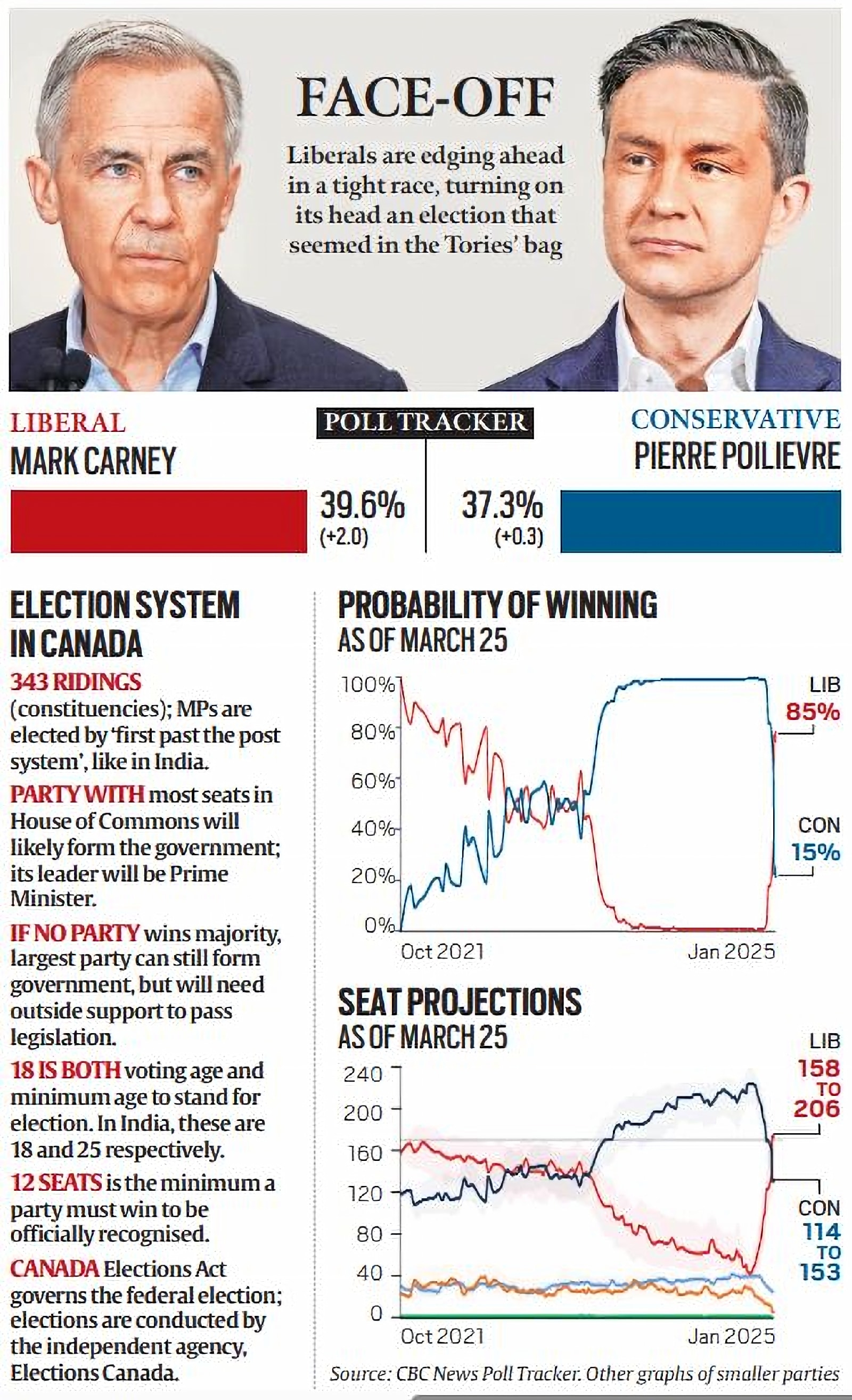How Donald Trump has turned the election in Canada
The Liberals, who until January had a near-zero chance of winning Canada’s election, are now frontrunners in the polls. If Mark Carney can lead his party to victory on April 28, he will have the US President to thank
 Liberals are edging ahead in a tight race, turning on its head an election that seemed in the Tories’ bag
Liberals are edging ahead in a tight race, turning on its head an election that seemed in the Tories’ bag On Sunday, his tenth day in office, Canada’s Prime Minister Mark Carney announced snap elections to the country’s Parliament, to be held on April 28.
Carney’s Liberal Party is neck and neck with the Conservatives in polling — a stunning turnaround from the beginning of this year, when the Liberals, led by Justin Trudeau at the time, were trailing the main opposition party by a yawning 20-plus points, and the outcome of the election, to be held before October 2025, seemed all but decided.
The reason for this dramatic change in Canada’s political situation is United States President Donald Trump.
The painful tariffs imposed by Trump, and his repeated threats to make Canada the “51st state” of the US, have fundamentally altered voters’ priorities. Many, including Carney himself, are calling the coming election the most consequential in Canada’s history.
The political landscape
Canadian politics has been historically dominated by two parties: the Liberals and the Conservatives (who have gone through various iterations since the 1800s). In recent years, the smaller Bloc Québécois (BQ) and New Democratic Party (NDP) have sometimes played kingmaking roles.
THE CONSERVATIVES, also called the Tories, have been led by Pierre Poilievre, 45, since 2022. Poilievre has been an MP since 2004, and held secretarial and ministerial positions in the government of Stephen Harper (2006-15).
As he tries to end almost 10 years of Liberal rule, Poilievre has put small government and low taxes at the heart of his message. To many Canadians struggling with a housing and affordability crisis, his promise of returning to “common sense politics” seemed a welcome alternative to Trudeau’s perceived “socialism”.
THE LIBERALS are no longer led by Trudeau, however. After serving as Prime Minister since November 2015, he stepped down from his party and government posts several months before the end of his second term — forced out by record low approval ratings and the tanking fortunes of his party.
Carney, whom the Liberals elected to succeed Trudeau, is a former governor of the Bank of Canada and the Bank of England, and is untested politically. But the 60-year-old has a reputation for being a steady, diplomatic hand — something that many voters believe Canada in its current situation needs desperately.
THE BC, established in 1991 and led currently by Yves-François Blanchet, supports the political secession of Quebec from the rest of Canada. The party contests exclusively within the province, where it will likely finish first or second in both vote share and seats.
THE NDP, led by Canadian Sikh Jagmeet Singh, supported Trudeau’s minority government between 2021 and 2024. Generally described as social democratic — it sits to the left of the Liberals on most issues — the NDP has consistently been the third or fourth largest party in the Canadian House of Commons.
THE GREENS and the far right PEOPLE’S PARTY OF CANADA may win a couple of seats, but are unlikely to influence the result.
What latest polling shows
According to the Poll Tracker published by CBC News, a division of Canada’s public broadcaster and the country’s largest news broadcaster, the Liberals are edging towards a third straight term in government.
As of Tuesday evening (in India), they were projected to win 39.6% of the vote, compared with 37.3% for the Conservatives, according to the Tracker, which relies on the weighted average of all publicly available polling data in Canada.
In terms of seat projections and probability of winning, the Liberals had opened up clear leads — 158-206 seats and 85% respectively — over the Conservatives (114-153 seats and 15% probability of winning).
“The Liberals are continuing to climb in the polls and are widening their lead over the Conservatives, putting them deeper into majority territory,” the Tracker said.

By contrast, on January 6, the Liberals were polling at 20.1% to the Conservatives’ 44.2%, and were projected to win just 29-57 seats compared with 206-244 for the Conservatives, who had a more than 99% chance of winning the election.
Apart from the Tories, the past two months have been rough for Jagmeet Singh’s party, whose projected voteshare has dropped from a high of 19.3% on January 6 to 11.4% on March 24. As things stand, the NDP, with a projected 6 seats, is at the risk of falling below the 12-seat threshold needed for official party status.
BC is polling at 6.4% nationally — a respectable 28.4% in Quebec, although down from the January 6 high of 36.6% — and is projected to win 26 seats.
The Donald Trump factor
Trudeau announced his resignation on January 6, which gave the Liberals a boost. That they were able to sustain the momentum was courtesy Trump. The Conservatives peaked at 44.8% on January 20, the day Trump was inaugurated, and have fallen consistently thereafter.
Canada, one of the US’ closest allies, was among the first countries to be targeted by Trump’s tariffs. The President also openly and repeatedly threatened Canada’s sovereignty, which upset and angered Canadians everywhere. Suddenly, “how to deal with Trump” became the most pressing issue in the country.
The extent to which the Liberals can leverage the anger against Trump will determine the outcome of the election. Carney starts with an advantage here — Poilievre has a particular (perceived) weakness when it comes to dealing with Trump.
He has in the past borrowed liberally from Trump’s playbook — from ranting against Trudeau’s “wokeism” and Canada’s corporate establishment to using phrases like “Canada First”, seemingly inspired by Trump’s “America First”. Critics have described him as “Trump Lite”.
This was all well and good when he was facing the incumbent Trudeau, the poster-boy of Canada’s liberal establishment, and when the political discourse focused on Canada’s domestic discontent. But Carney himself is a political outsider, and with foreign policy concerns now at the core issue in the election, Poilievre’s posturing falls a bit flat.
On Sunday, Carney told an applauding crowd: “While President Trump’s plan is to divide and conquer, Pierre Poilievre’s plan is to divide and be conquered”.
Poilievre’s search for an effective idiom to take on both Trump and the Liberals has not been successful so far. For the Liberals, on the other hand, Trump’s provocations have opened up a path to victory.
Carney has also moved fast to break from his predecessor. He has cancelled the carbon tax, a favourite target of Poilievre’s, undone Trudeau-era changes to the capital gains tax, and promised better fiscal discipline.
Thus far, the polls show that his early decisions, along with his credentials as an economist, have resonated with Canadians.





- 01
- 02

































